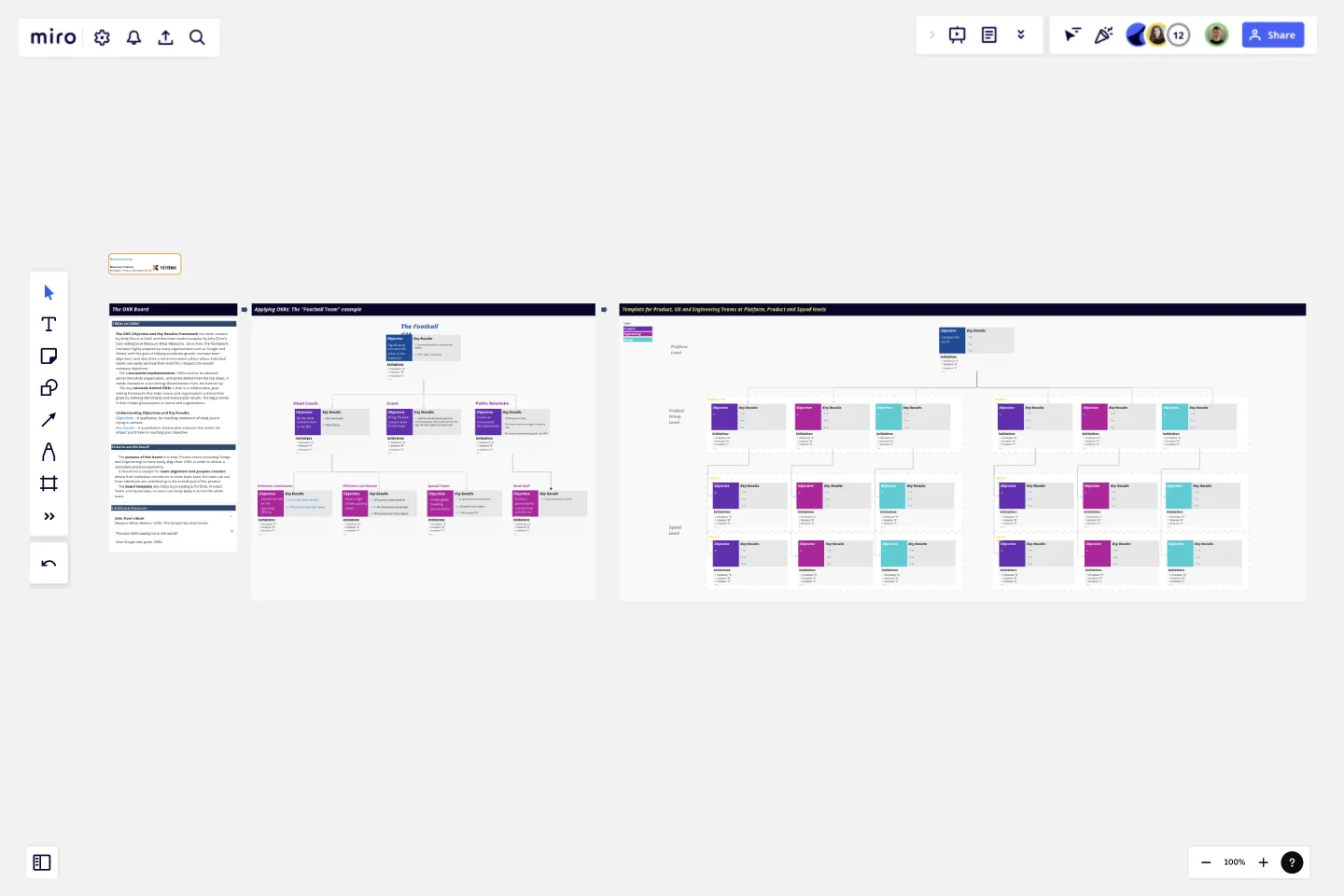OKR Board for Product, UX and Engineering Teams
The OKR (Objective and Key Results) framework has been created by Andy Grove at Intel, and then later made it popular by John Doer's best-selling book Measure What Measures.
The framework has been highly adopted by many organisations such as Google and Adobe, with the goal of helping accelerate growth, increase team alignment, and also drive a more innovative culture where individual teams can easily see how their work fits / impacts the overall company objectives.
For a successful implementation, OKRs need to be adopted across the whole organisation, and whilst define from the top down, it needs champions to be driving dissemination from, the bottom up.
The key rationale behind OKRs is that is a collaborative, goal-setting framework that helps teams and organisations achieve their goals by defining identifiable and measurable results. The big promise is that it helps give purpose to teams and organisations.
The purpose of this board is to help Product teams (including Design and Engineering) to more easily align their OKRs in order to deliver a consistent product experience.
It should act a catalyst for team alignment and purpose creation where from individual contributor to team leads level, the team can see how individuals are contributing to the overall goal of the product.
The board template also helps by providing a Portfolio, Product Team, and Squad view, so users can easily apply it across the whole team.
This template was created by Mauricio Franzoni.
Get started with this template right now.
Bull's Eye Diagram Template
Works best for:
Diagrams, Project Management, Prioritization
When you’re a growing organization, every decision can feel like it has make-or-break consequences—which can lead to decision paralysis, an inability to prioritize, inefficient meetings, and even low morale. If that sounds like you, put a Bull’s Eye Diagram to work. True to its name, a Bull’s Eye Diagram uses a model of concentric circles to help companies establish priorities, make critical decisions, or discuss how to remove or overcome obstacles.
PI Planning Template
Works best for:
PI Planning, Product Management
The Miro PI Planning Template streamlines the Program Increment planning process for Agile teams. It facilitates a collaborative environment, enabling teams to efficiently align on strategies, identify dependencies, and convert decisions into actionable tasks. With features like real-time collaboration, Jira integration, and a centralized workspace, the template supports teams in enhancing efficiency, engagement, and decision-making.
Product Thinking Board
Works best for:
Product Management, Planning
Product Thinking Board template encourages a user-centered approach to product development. By fostering empathy, collaboration, and experimentation, this template stimulates innovative thinking and problem-solving. With sections for user research, ideation, and prototyping, it supports iterative product design and validation. This template serves as a visual framework for product teams to engage in user-centric design thinking processes, driving the creation of products that truly meet user needs and deliver exceptional experiences.
Gantt Chart Project
Works best for:
Strategy, Planning
The Gantt Chart Project template is a versatile tool for managing various types of projects. It provides a clear visual timeline of your project's tasks, deadlines, and dependencies. Use it to plan, execute, and monitor your project's progress, ensuring all activities are aligned and on track. This template enhances team collaboration, improves time management, and helps address potential bottlenecks for successful outcomes.
English Grammar Timeline Builder
The English Grammar Timeline template helps you map out the progression of grammar concepts over time. This is a great tool for educators and students to visualize the sequence and relationship between different grammar topics, making learning and teaching more effective.
Technology Roadmap Template
Works best for:
Agile Methodology, Roadmaps, Agile Workflows
A technology roadmap helps teams document the rationale of when, why, how, and what tech-related solutions can help the company move forward. Also known as IT roadmaps, technology roadmaps show teams what technology is available to them, focusing on to-be-scheduled improvements. They allow you to identify gaps or overlap between phased-out tech tools, as well as software or programs soon to be installed. From a practical point of view, the roadmap should also outline what kinds of tools are best to spend money on, and the most effective way to introduce new systems and processes.
